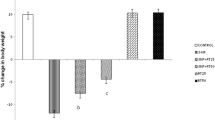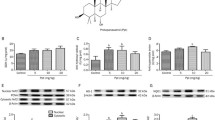Abstract
Mitochondrial abnormalities and redox imbalance are major pathogenic factors in progression of Huntington’s disease (HD), manifested clinically by affective, motor, cognitive, and psychiatric incompetence. Antioxidants behold much promise in mitigation of several pathological facets in HD. Ellagic acid (EA) is a naturally derived polyphenol acknowledged for potent neuroprotective abilities that enabled its significance amongst popular brain tonics. The present study is aimed to examine the outcome of EA pre-treatment in 3-nitropropionic acid (3-NP) rat prototype of HD. Separate rat groups were pre-treated with EA (25, 50, and 100 mg/kg, p.o.) for 21 days and 3-NP (10 mg/kg, i.p.) was given for 14 days alongside to induce symptoms of HD. The physical/motor functions (narrow beam paradigm, footprint study, hanging-wire assessment) and cognitive abilities using elevated plus maze and novel object recognition task were evaluated. Entire brain was isolated and succinate dehydrogenase activity and parameters of oxido-nitrosative stress were assessed in mitochondrial fraction. 3-NP accrued oxido-nitrosative stress and significant decrease in succinate dehydrogenase activity caused motor and cognitive deficits in rats. EA pre-treatment resurrected succinate dehydrogenase activity in 3-NP treated rats that indicated preservation of mitochondrial function. A significant decrease in thiobarbituric acid reactive substances and nitrite levels and increase in glutathione and catalase activity by EA in 3-NP treated rats was noted. EA protected the rats against 3-NP triggered cognitive insufficiency and motor disturbances. It can be inferred that ellagic acid protects against 3-NP induced mitochondrial dysfunction and oxido-nitrosative stress in the brain. EA supplements or nutraceuticals might possess protective potential against symptoms of HD.






Similar content being viewed by others
Data availability
The data are available.
References
Ambrose SS, Solairaj P, Subramoniam A (2013) Effectiveness of ellagic acid on isoniazid-rifampicin induced liver damage in rats. J Pharmacol Pharmacother 4(1):60–62. https://doi.org/10.4103/0976-500X.107685
Aslan A, Gok O, Beyaz S, Arslan E, Erman O, Agca CA (2020) The preventive effect of ellagic acid on brain damage in rats via regulating of Nrf-2, NF-kB and apoptotic pathway. J Food Biochem 44(6):e13217. https://doi.org/10.1111/jfbc.13217
Ayala MMF, Arguelles S (2014) Lipid peroxidation: production, metabolism, and signaling mechanisms of malondialdehyde and 4-hydroxy-2-nonenal. Oxid Med Cell Longev 2014:360438. https://doi.org/10.1155/2014/360438
Baluchnejadmojarad T, Rabiee N, Zabihnejad S, Roghani M (2017) Ellagic acid exerts protective effect in intrastriatal 6-hydroxydopamine rat model of Parkinson’s disease: possible involvement of ERβ/Nrf2/HO-1 signaling. Brain Res 1662:23–30. https://doi.org/10.1016/j.brainres.2017.02.021
Brouillet E, Jacquard C, Bizat N, Blum D (2005) 3-Nitropropionic acid: a mitochondrial toxin to uncover physiopathological mechanisms underlying striatal degeneration in Huntington’s disease. J Neurochem 95(6):1521–1540. https://doi.org/10.1111/j.1471-4159.2005.03515.x
Carmo C, Naia L, Lopes C, Rego AC (2018) Mitochondrial dysfunction in Huntington’s disease. Adv Exp Med Biol 1049:59–83. https://doi.org/10.1007/978-3-319-71779-1_3
Chen P, Chen F, Zhou B (2018) Antioxidative, anti-inflammatory and anti-apoptotic effects of ellagic acid in liver and brain of rats treated by D-galactose. Sci Rep 8:1465. https://doi.org/10.1038/s41598-018-19732-0
Claiborne A (1985) Catalase activity. In: Greenwald RA (ed) CRC handbook of methods for oxygen radical research. CRC Press, Boca Raton, pp 283–284
de Oliveira MR (2016) The effects of ellagic acid upon brain cells: a mechanistic view and future directions. Neurochem Res 41(6):1219–1228. https://doi.org/10.1007/s11064-016-1853-9
Dhadde SB, Nagakannan P, Roopesh M, Anand Kumar SR, Thippeswamy BS, Veerapur VP, Badami S (2016) Effect of embelin against 3-nitropropionic acid-induced Huntington’s disease in rats. Biomed Pharmacother 77:52–58. https://doi.org/10.1016/j.biopha.2015.11.009
Ellman GL (1959) Tissue sulfhydryl groups. Arch Biochem Biophys 82(1):70–77. https://doi.org/10.1016/0003-9861(59)90090-6
Ennaceur A, Delacour J (1988) A new one-trial test for neurobiological studies of memory in rats. Behav Brain Res 31:47–59. https://doi.org/10.1016/0166-4328(88)90157-X
Firdaus F, Zafeer MF, Anis E, Ahmad M, Afzal M (2018) Ellagic acid attenuates arsenic induced neuro-inflammation and mitochondrial dysfunction associated apoptosis. Toxicol Rep 5:411–417. https://doi.org/10.1016/j.toxrep.2018.02.017
Gil-Mohapel J, Brocardo PS, Christie BR (2014) The role of oxidative stress in Huntington’s disease: are antioxidants good therapeutic candidates? Curr Drug Targets 15(4):454–468. https://doi.org/10.2174/1389450115666140115113734
Gipson TA, Neueder A, Wexler NS, Bates GP, Housman D (2013) Aberrantly spliced HTT, a new player in Huntington’s disease pathogenesis. RNA Biol 10(11):1647–1652. https://doi.org/10.4161/rna.26706
Gonzalez-Sarrias A, Garcia-Villalba R, Nunez-Sanchez MA, Tome-Carneiro J, Zafrilla P, Mulero J, Tomas-Barberan FA, Espin JC (2015) Identifying the limits for ellagic acid bioavailability: a crossover pharmacokinetic study in healthy volunteers after consumption of pomegranate extracts. J Funct Foods 19(Part A):225–235. https://doi.org/10.1016/j.jff.2015.09.019
Hamad AWR, Al-Momani WM, Janakat S, Oran SA (2009) Bioavailability of ellagic acid after single dose administration using HPLC. Pak J Nutr 8:1661–1664. https://doi.org/10.3923/pjn.2009.1661.1664
Hands S, Sajjad MU, Newton MJ, Wyttenbach A (2011) In vitro and in vivo aggregation of a fragment of huntingtin protein directly causes free radical production. J Biol Chem 286(52):44512–44520. https://doi.org/10.1074/jbc.M111.307587
Hoseiny NK, Alireza S, Mahin D, Yaghoob F, Mohammad B, Mohammad Kazem GN (2017) Preventive effects of ellagic acid on nucleus tractus solitarius electrical activity and oxidative stress altered by cerebral global ischemia/reperfusion in rat. Braz Arch Biol Technol 60:e17160264. https://doi.org/10.1590/1678-4324-2017160264
Johri A, Beal MF (2012) Antioxidants in Huntington’s disease. Biochim Biophys Acta 5:664–674. https://doi.org/10.1016/j.bbadis.2011.11.014
Kaur N, Jamwal S, Deshmukh R, Gauttam V, Kumar P (2015) Beneficial effect of rice bran extract against 3-nitropropionic acid induced experimental Huntington’s disease in rats. Toxicol Rep 2:1222–1232. https://doi.org/10.1016/j.toxrep.2015.08.004
Kiasalari Z, Heydarifard R, Khalili M, Afshin-Majd S, Baluchnejadmojarad T, Zahedi E, Sanaierad A, Roghani M (2017) Ellagic acid ameliorates learning and memory deficits in a rat model of Alzheimer’s disease: an exploration of underlying mechanisms. Psychopharmacology 234(12):1841–1852. https://doi.org/10.1007/s00213-017-4589-6
Kim GH, Kim JE, Rhie SJ, Yoon S (2015) The role of oxidative stress in neurodegenerative diseases. Exp Neurobiol 24(4):325–340. https://doi.org/10.5607/en.2015.24.4.325
King TE, Ohnishi T, Winter DB, Wu JT (1976) Biochemical and EPR probes for structure-function studies of iron sulfur centers of succinate dehydrogenase. Adv Exp Med Biol 74:182–227
Kovtun V, Liu Y, Bjoras M, Klungland A, Wilson SH, McMurray CT (2007) OGG1 initiates age-dependent CAG trinucleotide expansion in somatic cells. Nature 447(7143):447–452. https://doi.org/10.1038/nature05778
Kumar A, Ratan RR (2016) Oxidative stress and Huntington’s disease: the good, the bad, and the ugly. J Huntingtons Dis 5(3):217–237. https://doi.org/10.3233/JHD-160205
Kumar M, Bansal N (2018a) Ellagic acid prevents dementia through modulation of PI3-kinase-endothelial nitric oxide synthase signalling in streptozotocin-treated rats. Naunyn Schmiedebergs Arch Pharmacol 391(9):987–1001. https://doi.org/10.1007/s00210-018-1524-2
Kumar M, Bansal N (2018b) Fasudil hydrochloride ameliorates memory deficits in rat model of streptozotocin-induced Alzheimer’s disease: involvement of PI3-kinase, eNOS and NFκB. Behav Brain Res 351:4–16. https://doi.org/10.1016/j.bbr.2018.05.024
Landete JM (2011) Ellagitannins, ellagic acid and their derived metabolites: a review about source, metabolism, functions and health. Food Res Int 44(5):1150–1160. https://doi.org/10.1016/j.foodres.2011.04.027
Lin SS, Hung CF, Ho CC, Liu YH, Ho HC, Chung JG (2000) Effects of ellagic acid by oral administration on N-acetylation and metabolism of 2-aminofluorene in rat brain tissues. Neurochem Res 25(11):1503–1508. https://doi.org/10.1023/a:1007632326953
Lipinska L, Klewicka E, Sojka M (2014) The structure, occurrence and biological activity of ellagitannins: a general review. Acta Sci Pol Technol Aliment 13(3):289–299. https://doi.org/10.17306/J.AFS.2014.3.7
Long D, Matson WR, Juhl AR, Leavitt BR, Paulsen JS (2012) 8OHdG as a marker for Huntington disease progression. Neurobiol Dis 46(3):625–634. https://doi.org/10.1016/j.nbd.2012.02.012
Lowry H, Rosebrough NJ, Farr AL, Randall RJ (1951) Protein measurement with the folin phenol reagent. J Biol Chem 193:265–275
Lum PT, Sekar M, Gan SH, Bonam SR, Shaikh MF (2021) Protective effect of natural products against Huntington’s disease: an overview of scientific evidence and understanding their mechanism of action. ACS Chem Neurosci 12(3):391–418. https://doi.org/10.1021/acschemneuro.0c00824
Lushchak VI (2012) Glutathione homeostasis and functions: potential targets for medical interventions. J Amino Acids 2012:736837. https://doi.org/10.1155/2012/736837
Mansouri MT, Farbood Y, Naghizadeh B, Shabani S, Mirshekar MA, Sarkaki A (2016) Beneficial effects of ellagic acid against animal models of scopolamine- and diazepam-induced cognitive impairments. Pharm Biol 54(10):1947–1953. https://doi.org/10.3109/13880209.2015.1137601
McColgan P, Tabrizi SJ (2018) Huntington’s disease: a clinical review. Eur J Neurol 25(1):24–34. https://doi.org/10.1111/ene.13413
Ohkawa H, Ohishi N, Yagi K (1979) Assay for lipid peroxides in animal tissues by thiobarbituric acid reaction. Anal Biochem 95(2):351–358. https://doi.org/10.1016/0003-2697(79)90738-3
Reilmann R, Leavitt BR, Ross CA (2014) Diagnostic criteria for Huntington’s disease based on natural history. Mov Disord 29(11):1335–1341. https://doi.org/10.1002/mds.26011
Roos RA (2010) Huntington’s disease: a clinical review. Orphanet J Rare Dis 5:40. https://doi.org/10.1186/1750-1172-5-40
Sandhir R, Mehrotra A, Kamboj SS (2010) Lycopene prevents 3-nitropropionic acid induced mitochondrial oxidative stress and dysfunctions in nervous system. Neurochem Int 57(5):579–587. https://doi.org/10.1016/j.neuint.2010.07.005
Sastry KV, Moudgal RP, Mohan J, Tyagi JS, Rao GS (2002) Spectrophotometric determination of serum nitrite and nitrate by copper-cadmium alloy. Anal Biochem 306(1):79–82. https://doi.org/10.1006/abio.2002.5676
Seeram NP, Lee R, Heber D (2004) Bioavailability of ellagic acid in human plasma after consumption of ellagitannins from pomegranate (Punica granatum L.) juice. Clin Chim Acta 348(1–2):63–68. https://doi.org/10.1016/j.cccn.2004.04.029
Stack EC, Matson WR, Ferrante RJ (2008) Evidence of oxidant damage in Huntington’s disease: translational strategies using antioxidants. Ann N Y Acad Sci 1147:79–92. https://doi.org/10.1196/annals.1427.008
Sun X, Zhu J, Sun XY, Ji M, Yu XL, Liu RT (2020) Ellagic acid rescues motor and cognitive deficits in the R6/2 mouse model of Huntington’s disease by lowering mutant huntingtin protein. Food Funct 11(2):1334–1348. https://doi.org/10.1039/c9fo02131k
Tunez I, Tasset I, Perez-De La Cruz V, Santamaria A (2010) 3-Nitropropionic acid as a tool to study the mechanisms involved in Huntington’s disease: past, present and future. Molecules 15(2):878–916. https://doi.org/10.3390/molecules15020878
van Duijn E, Kingma EM, van der Mast RC (2007) Psychopathology in verified Huntington’s disease gene carriers. J Neuropsychiatry Clin Neurosci 19(4):441–448. https://doi.org/10.1176/jnp.2007.19.4.441
Vasudevan M, Parle M (2007) Memory-enhancing activity of Thespesia populnea in rats. Pharm Biol 45(4):267–273. https://doi.org/10.1080/13880200701214631
Vattem DA, Shetty K (2005) Biological functionality of ellagic acid: a review. J Food Biochem 29(3):234–266. https://doi.org/10.1111/j.1745-4514.2005.00031.x
Acknowledgements
The authors are thankful to the management of A.S.B.A.S.J.S.M. College of Pharmacy, Bela (Ropar) for providing the necessary research facilities.
Author information
Authors and Affiliations
Contributions
NB conceived and designed this research. PS and MK conducted experiments. MK drafted the original and revised manuscript. All authors read and approved the final manuscript. The authors declare that all data were generated in-house and that no paper mill was used.
Corresponding author
Ethics declarations
Ethical approval
This study was approved by the “Institutional Animal Ethics Committee (IAEC)” of the A.S.B.A.S.J.S.M. College of Pharmacy, Bela (Ropar) vide protocol no. ASCB/IAEC/09/16/113 (dated: 24–09-2016). The guidelines of “The Committee for the Purpose of Control and Supervision of Experiments on Animals (CPCSEA),” Ministry of Forests & Environment, and Government of India (New Delhi) were followed for all animal experiments and care of animals.
Consent to participate
Not applicable.
Consent to publish
All authors have agreed to publish this study.
Competing interests
The authors declare no competing interests.
Additional information
Publisher's note
Springer Nature remains neutral with regard to jurisdictional claims in published maps and institutional affiliations.
Supplementary Information
Below is the link to the electronic supplementary material.
Rights and permissions
About this article
Cite this article
Sharma, P., Kumar, M. & Bansal, N. Ellagic acid prevents 3-nitropropionic acid induced symptoms of Huntington’s disease. Naunyn-Schmiedeberg's Arch Pharmacol 394, 1917–1928 (2021). https://doi.org/10.1007/s00210-021-02106-1
Received:
Accepted:
Published:
Issue Date:
DOI: https://doi.org/10.1007/s00210-021-02106-1




